The Ultimate Guide To Trolling Flies For Salmon
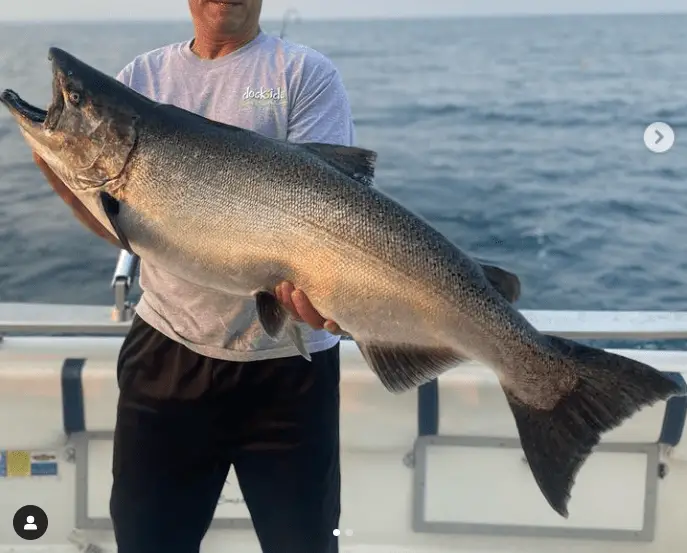
A trolling fly mimics local food sources such as smelt, herring, or other baitfish that the salmon feed on. When using trolling flies for salmon, you can fish at the depths where salmon are holding by using downriggers, lead core lines, wire lines, and Dipsy Divers.
Key Takeaways
- Picking The Right Trolling Flies: Most experts believe the best trolling flies will match the hatch or the predominant baitfish that the salmon are feeding on. To do this they will experiment with colors, flash, and fly size to determine what the salmon want.
- The Best Trolling Flies: Trolling flies can be made from many different materials, such as natural hairs like bucktail and polar bear, but they can also use synthetic materials that have flash and good movement in the water. I reveal 6 of the best trolling flies and what charter captain use the most.
- How To Fish Trolling Flies: Dowriggers, lead core line, Dipsy Divers, and planner boards are used with trolling flies. Trolling flies can be fished by themselves or with a dodger or flasher to attract salmon and to create more action on the fly.
- Ideal Leader Lenght: We discuss leader lengths used. The ideal leader lengths are usually 12 to 32 inches. Many charter captains will use a leader length 2 or 3 times longer than their flasher or dodger, but other factors need to be considered.
- What Pound Leader: While some prefer a stronger leader of 40 or 50 pounds, some find that size too stiff and that affects the flies’ action. Some anglers will use 30 pounds instead. It’s good to try different sizes to see what the salmon want.
- Trolling Fly Setups: Having the right setup is critical for putting more salmon in the net. The setup includes the type of leader used, whether that be fluorocarbon or mono, both are used, as well as proper knots, and leader length.
In this article, I’ll share the tips and tactics used by top charter captains and veteran salmon anglers.
Trolling Flies Depth and Action
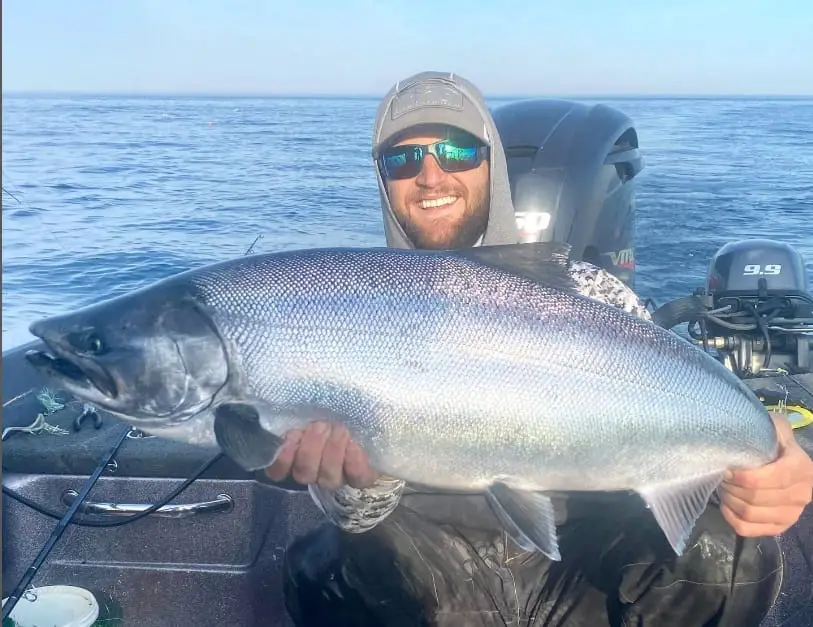
Trolling flies are designed to be fished deep when necessary, but they also work in shallower waters when you are targeting king salmon that have moved up shallow to feed on baitfish.
The idea behind the trolling fly is to draw their attention visually with the motion and flash of the trolling flies. Salmon may even sense the flies with the lateral lines on the sides of their bodies.
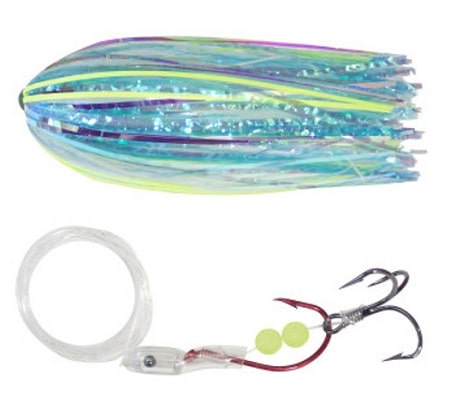
A trolling fly might not look like something you’d expect to see in nature when it’s in your fly box, but when it’s moving through the water, the movement and action of the fly created by trolling makes trolling flies look perfectly natural to the fish.
The action of the fly is determined by speed, length of leader, leader stiffness, and whether you are using a dodger or flasher.
Ideal Trolling Speed For Trolling Flies For Salmon
You can troll at any speed with trolling flies however, you should really be trolling at the speed the salmon prefer. I discuss this speed in my article on Trolling For Salmon.
The speed you troll at can also be determined by the dodger or flasher you are using since some run better at different speeds. Ideal speeds are usually 1.5mph to 2.3mph.
To be sure, your dodger should wobble and dart like a wounded baitfish, and not spin. Check the action of the dodger and the fly at the side of the boat before you drop it down deep.
Trolling Techniques and Equipment
There are three preferred methods used when trolling flies, Downriggers, Dispy Divers, and Lead Core lines. The use of flashers and dodges can be an asset.
Trolling Flies With Downriggers
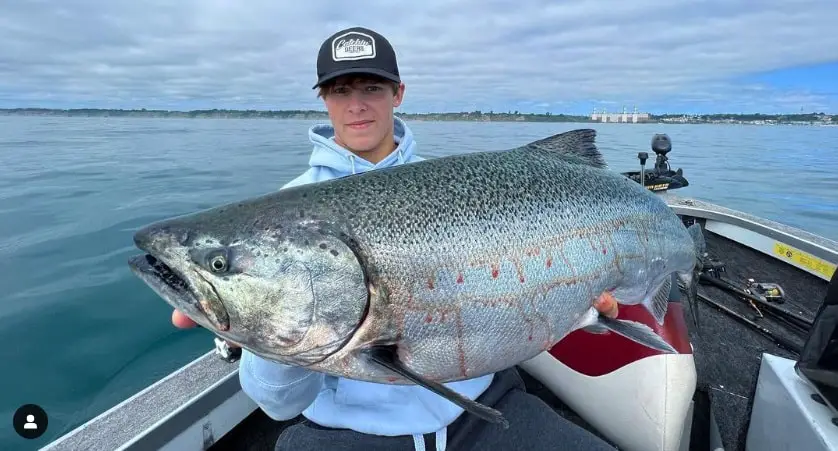
Downriggers are important equipment when using trolling flies to target salmon, lake trout, and steelhead that are in deep waters. See my article Best Downriggers For Salmon.
A downrigger makes it a lot easier to get trolling flies down to the exact depths where the fish are located by your fish finder and GPS unit. See my article on the best fish finders for salmon. It doesn’t matter if you are fishing off the West Coast or in the Great Lakes, without a downrigger, it’s difficult to get exact depths.
Charter captains prefer not to use weighted trolling flies since they don’t look or act naturally while at depth.
Fishing Trolling Flies With Dodgers and Flashers
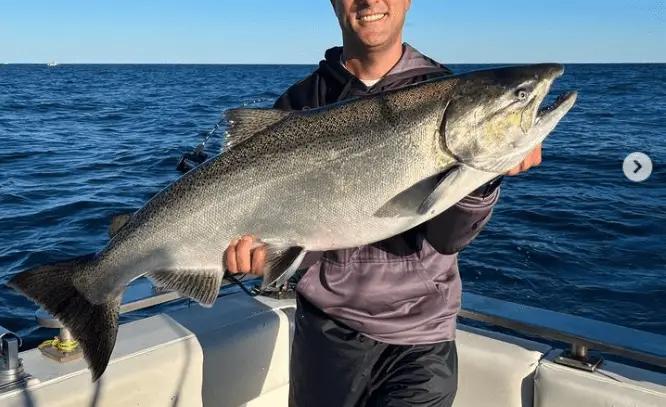
In addition to downriggers, many who use trolling flies also use flashers and dodgers to give the fly more action. The flashers and dodgers make trolling flies move erratically from side to side or a rolling action.
The dodger and flasher are large and will attract the salmon from a distance and as the salmon moves in it will see the easy trailing target, also known as your trolling fly.
The idea is to make them act like injured prey and an easy meal.
There are days when the salmon will prefer an erratic trolling fly behind a flasher, and other days, the salmon may be deterred by the dodger and flasher. Some people who use trolling flies don’t like the erratic movements and prefer a more natural presentation without flashers and dodgers. It’s best to experiment and let the salmon decide what they want.
Trolling Flies With Lead Lines
When salmon and trout are closer to the water’s surface, short lead core lines will work to get the flies to the right depth. Add more lead line out to get more depth. Lead lines are common on many charter boats. See Best Lines For Salmon Trolling.
Trolling Flies With Dipsy Divers
Some fishermen also use dipsy divers and wire lines to troll flies. The dipsy diver dives deep and the wire lines create a vibration in the water which can attract the salmon.
Trolling Flies With Planner Boards
Using planner boards is a great way to spread your lines and flies out at the side of the boat so that you can cover more water.
Trolling Flies Setup
Some experts suggest that your setup or leader length and size should all be the same so that all your flies are consistent and run the same. Others will tell you to vary the sizes and lengths to try to determine what the salmon want.
There are things you can do to change the action of your trolling flies.
What Lenght Leader For Trolling Flashers For Salmon?
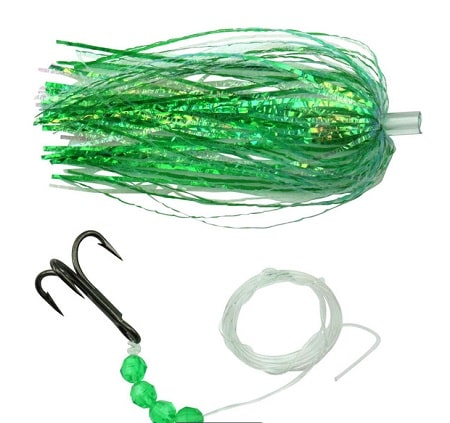
Capt. Mike Schoonveld explains that the old rule of thumb was that your leader should be one and a half the length of your dodger or flasher. An 8″ dodger meant a 12″ leader.
But that’s an old rule, however, it still works. Many anglers and charter captains are now going two times, three times, and even four times the length of the dodger or flasher.
The most common length is two times the length of your dodger or flasher.
Now, I have no rule to follow and if anything the leader lengths I use now are more on the long side than the short side.
Capt. Mike Schoonveld
What Pound Leader For Trolling Flashers For Salmon?
The pound leader for trolling flashers for salmon is 30 to 50 pounds. 30 pounds leader is less stiff and believed to provide more action to the fly, but a 40 and 50-pound leader is much stronger and has fewer break offs.
Many charter captains will tell you to mix it up to find out if the salmon prefer a certain action.
Fluorocarbon Leaders Or Monofillament Leaders For Trolling Flies For Salmon
Booth Fluorocarbon leaders and monofilament leaders are used for trolling flies for salmon.
Fluorocarbon leaders are stiffer, but they are less visible and more abrasion-resistant. Being less visible is a good thing since salmon will not bite flies if they see the leader.
Monofilament leaders are also good, and some anglers prefer them since they are not as stiff and are less expensive. However, they are more visible to the fish, and this matters sometimes.
Choosing The Right Trolling Fly
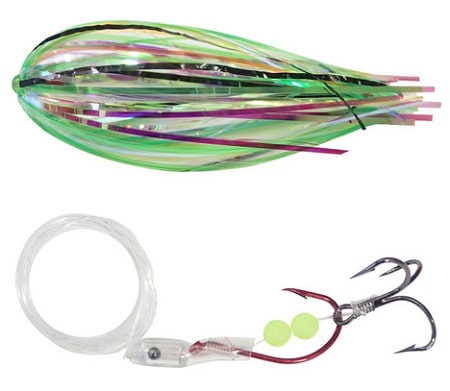
You should consider many factors when selecting the right trolling flies to increase your chances of catching more fish.
The first is what the local food sources are that the fish you are targeting commonly eat. Try to use trolling flies that mimic the size, shape, and color.
You should also consider the water conditions, especially the temperature, depth and light penetration, and whether the water is clear or murky.
At certain depths, some colors stand out better. So, run different color trolling flies on different rods at the same time to determine what the salmon want.
Even glow-trolling flies like the Moonshine Lures Trolling Fly can be a good option, especially during low light and very deep water.
Popular Trolling fly colors and their effectiveness:
- Shades of green work well in the middle of summer and when water clarity is a bit murky, and the sky is overcast. They also work when fished deep.
- Glow/chartreuse are good for catching fish’s eye with trolling flies when the water is clear and the sun is shining, and when fishing deep.
- Black/chartreuse/purple is another good color combination to use on trolling flies that you fish in deep waters for bigger fish.
- Chartreuse, blues, and silvers for the early season salmon.
- Reds and purples for staging period in the late summer when salmon are readying for their annual spawning run up local rivers and streams.
Banded mylar, deer hair, and varying bright colors are popular for tying trolling flies that you tie to catch salmon and trout.
Bucktail is great for adding density to the fly while the brighter colors and mylar materials create an eye-catching presentation for salmon. Add some flas to some of your flies.
Using a #2 J hook can give you a good starting point for tying your own flies.
The Best Trolling Flies For Salmon Fishing
- A-TOM-MIK Tournament Series Trolling Fly: High-quality material provides excellent action to the fly, and has a built-in rattle to attract more salmon.
- Howie Tackle Howie Fly: Very popular and a favorite of many salmon anglers. They are hand-tied using the best material, and they are made in the USA
- Rapture Trolling Fly: Known as the coho trolling fly with a treble hook and 50 pounds of Ande mono leader so you can adjust your leader size to your needs.
- A-TOM-MIK Live Tournament Series Trolling Fly: Made with durable synthetic mylar and tinsels for extra flash and movement.
- A-TOM-MIK Custom Trolling Fly: Lots of flash and tinsel with a built-in rattle and 30 inches of 50-pound fluorocarbon.
- Rapture Trolling Flies Coho Trolling Fly: As the name suggests, it’s a fly designed to catch coho salmon.
Tying Your Own Trolling Flies
Tying your own trolling flies is a great way to match the local natural food sources and create excellent salmon trolling flies.
You might try some of the more popular patterns for trolling flies, including the:
- Hulk Fly
- Mooneye
- UV 190
- 41 Fly
- Stud Fly
Innovative Approaches and Ideas
Using lips on flies to eliminate the need for a flasher is terrific for making the trolling flies look more natural by giving them a side-to-side motion that makes them look authentic to fish.
Salmon, trout, and other species can detect the movement with their highly sensitive lateral lines.
What are the best flies for trolling for salmon?
There are lots of trolling flies and I’ve heard anglers using and doing well with standard streamers used for salmon and steelhead in the river. Even flies like a Clouser or the Willie Gunn salmon fly can work. But most charter captains use flies designed for trolling like the A-TOM-MIK Trolling Flies.
What is the best hook for salmon trolling flies?
High-quality treble hooks like the premium VMC hooks are the best hooks for salmon trolling flies. A size 2 J-hook or wide-gape Octopus hooks are also good.
What are the best colors for salmon trolling flies?
Greens and blues combined with silver or added flash are the best colors for salmon trolling flies.
